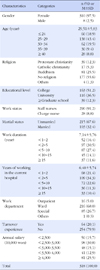Abstract
Purpose
This study was designed to construct a structural equation model and identify the effects and relationships of self-efficacy, career plateau, job embeddedness, organizational commitment and intent to turnover for nurses. Also, an attempt was made to derive a hypothetical model from these factors and to verify whether the model has validity as a means of explaining and anticipating turnover intention of nurses.
Methods
Data were collected from six randomly selected hospitals: a university hospital located in J city, Kyungnam and five general hospitals located in two cities (cities B and C), each having 400 to 720 beds. Also, 318 nurses were surveyed. Data were analyzed using SPSS 21.0 and AMOS 18.0 program.
Results
Job embeddedness and organizational commitment were identified as the most likely paths to turn over intention. Also, organizational commitment had the highest direct effect on turnover intention followed by job embeddedness and then self-efficacy, but career plateau had an indirectly effected turnover intention.
References
1. Jeong JH, Kim JS, Kim KH. The risk factors influencing turnover intention of nurses. J Korean Acad Nurs Adm. 2008; 14(1):35–44.
2. Hospital Nurses Association. Hospital nurse staffing status survey. Business Report. Seoul: Hospital Nurses Association;2014.
3. Srivastava S. Job satisfaction and organizational commitment relationship: Effect of personality variables. J Bus Perspect. 2013; 17(2):159–167. DOI: 10.1177/0972262912483529.
4. Jones CB. The costs of nurse turnover, part 2. J Nurs Adm. 2005; 35(1):41–49. DOI: 10.1097/00005110-200412000-00006.
5. Waldman JD, Kelly F, Arora S, Smith HL. The shocking cost of turnover in health care. Health Care Manage Rev. 2004; 29(1):2–7.
6. Peltier JW, Schibrowsky JA, Nill A. A hierarchical model of the internal relationship marketing approach to nurse satisfaction and loyalty. Eur J Mark. 2013; 47(5):899–916. DOI: 10.1108/03090561311306967.
7. Clarke SP, Aiken LH. Failure to rescue. Am J Nurs. 2003; 103(1):42–47.
8. O'Brien-Pallas L, Murphy GT, Shamian J, Li X, Hayes LJ. Impact and determinants of nurse turnover: A pan-Canadian study. J Nurs Manag. 2010; 18(8):1073–1086. DOI: 10.1111/j.1365-2834.2010.01167.x.
9. Kim JK, Kim MJ. A review of research on hospital nurses' turnover intention. J Korean Acad Nurs Adm. 2011; 17(4):538–550.
10. Allen TD, Russell JEA, Poteet ML, Dobbins GH. Learning and development factors related to perceptions of job content and hierarchical plateauing. J Organ Behav. 1999; 20(7):1113–1137. DOI: 10.1002/(SICI)1099-1379(199912).
11. Kim YM, Kang YS. The relationship among career plateau, self-efficacy, job embeddedness and turnover intention of nurses in small and medium sized hospitals. J Korea Acad Ind Coop Soc. 2013; 14(10):5078–5090.
12. Armstrong-Stassen M. Factors associated with job content plateauing among older workers. Career Dev Int. 2008; 13(7):594–613. DOI: 10.1108/13620430810911074.
13. Heilmann SG, Holt DT, Rilovick CY. Effects of career plateauing on turnover: A test of a model. J Leadersh Organ Stud. 2008; 15(1):59–68. DOI: 10.1177/1548051808317999.
14. Bae EK, Kang MG, Lee HJ, Kim DY. The moderating effect of career plateau on the relationship between careers satisfaction and turnover intention of HRD consultants. J Korean Assoc Human Resour Dev. 2012; 7(1):93–112.
15. Jeon WB, Moon SJ. A study on antecedents of hotel employees' perception of career plateau, organizational commitment and turnover intention. Korean J Tourism Res. 2008; 22(4):43–67.
16. Mitchell TR, Holtom BC, Lee TW, Sablynski CJ, Erez M. Why people stay: Using job embeddedness to predict voluntary turnover. Acad Manage J. 2001; 44(6):1102–1122. DOI: 10.2307/3069391.
17. Park GG, Lee KE. A study on the relationship between job embeddedness and turnover intention in Korea. J Bus Res. 2004; 33(5):1423–1440.
18. Holtom BC, O'Neill BS. Job embeddedness: A theoretical foundation for developing a comprehensive nurse retention plan. J Nurs Adm. 2004; 34(5):216–227. DOI: 10.1097/00005110-200405000-00005.
19. Ha DH, Kim JS. Effects of job embeddedness and role stressors of hotel employees on job satisfaction, organizational commitment and turnover intention. Korean J Tourism Res. 2010; 24(6):173–191.
20. Kim EH, Lee E, Choi HJ. Mediation effect of organizational citizenship behavior between job embeddedness and turnover intention in hospital nurses. J Korean Acad Nurs Adm. 2012; 18(4):394–401.
21. Min S, Kim HS, Ha YJ, Kim EA, Kim HY, Kim HJ, et al. The controlling effect of the self-efficacy in the job stress of hospital nurse on job satisfaction, turnover intention. Korean J Bus Adm. 2011; 24(1):1–21.
22. Moon YS, Han SJ. Impact of self-efficacy and nursing professionalism on organizational commitment in nurses. J Korean Acad Soc Nurs Educ. 2011; 17(1):72–79.
23. Lee MH. Relationship between organizational culture types and organizational effectiveness in hospitals [dissertation]. Chungnam: Chungnam National University;1998.
24. Beecroft PC, Dorey F, Wenten M. Turnover intention in new graduate nurses: A multivariate analysis. J Adv Nurs. 2008; 62(1):41–52. DOI: 10.1111/j.1365-2648.2007.04570.x.
25. Moon SJ. Structural model of nurses' intentions of changing workplaces [dissertation]. Seoul: Kyunghee University;2010.
26. Milliman JF. Causes, consequences, and moderating factors or career plateauing [dissertation]. California: University of Southern California;1992.
27. Sherer M, Maddux JE, Mercandante B, Prentice-Dunn S, Jacobs B, Rogers RW. The self-efficacy scale: construction and validation. Psychol Rep. 1982; 51:663–671.
28. Oh GS. Nursing Concept Casebook. Yonsei University;1993.
29. Mowday RT, Steers RM, Porter LW. The measurement of organizational commitment. J Vocat Behav. 1979; 14:224–247. DOI: 10.1016/0001-8791(79)90072-1.
30. Mobley WH. Employee turnover: causes, consequences, and control. MA: Addison-Wesley;1982.




 PDF
PDF ePub
ePub Citation
Citation Print
Print







 XML Download
XML Download